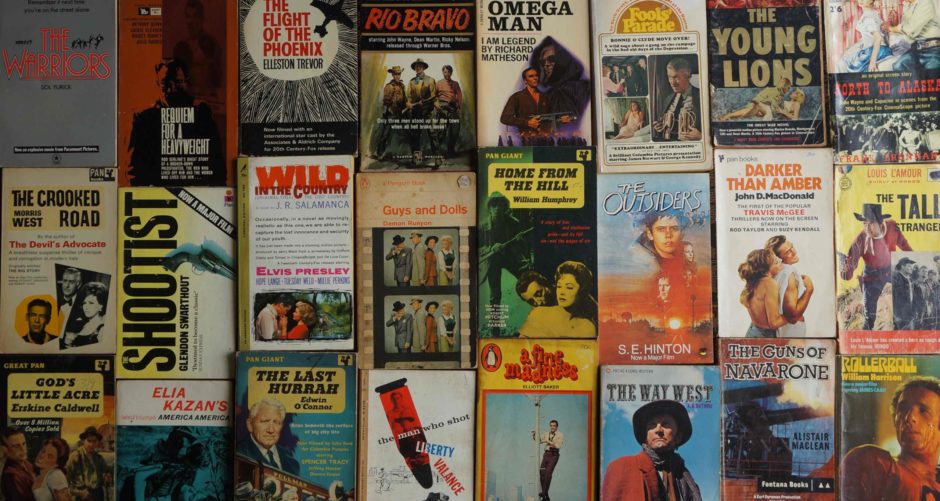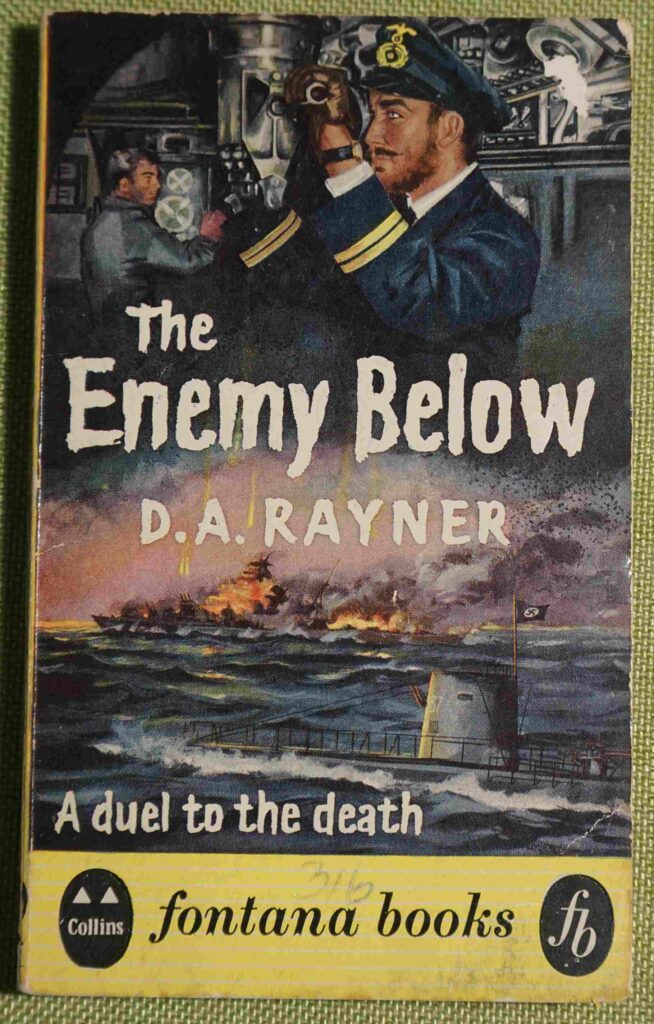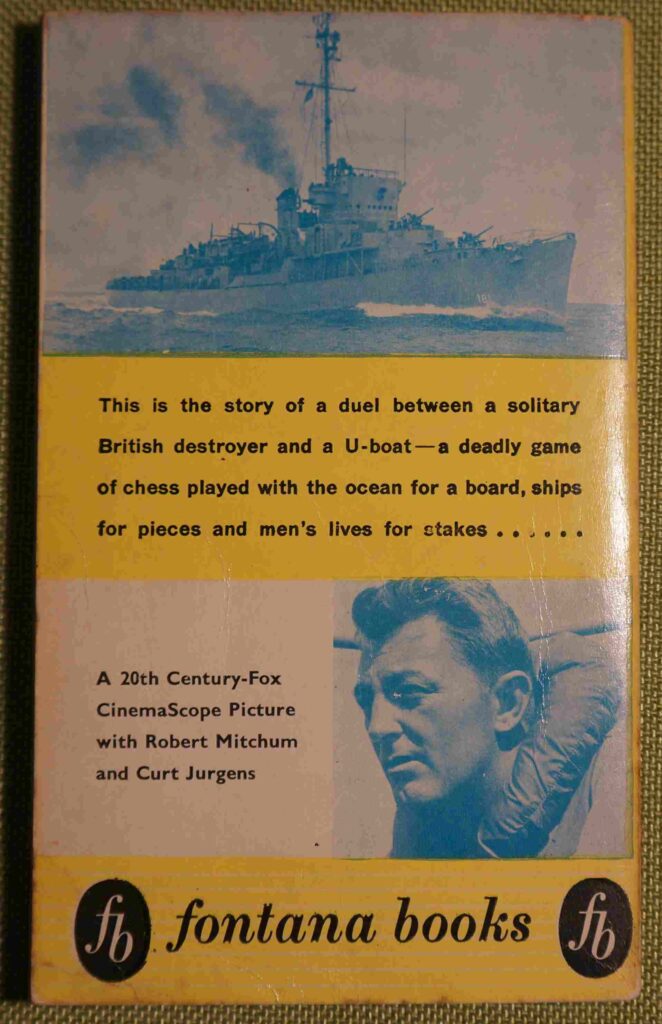FILM DIRECTOR: Dick Powell
SCREENWRITER: Wendell Mayes
FILM STARS: Robert Mitchum, Curd Jürgens, Theodore Bikel, David Hedison, Russell Collins, Kurt Kreuger, Frank Albertson, Biff Elliot, Ralph Manza, Doug McClure, Darryl F. Zanuck
COUNTRY: USA
THIS BOOK
AUTHOR: D.A. Rayner
TYPE: Novel
PUBLISHER: Fontana Books
THIS EDITION PUBLISHED: 1958
COUNTRY: Great Britain
COVER: Paperback
THE ORIGINAL BOOK
ORIGINAL AUTHOR: As Above
YEAR FIRST PUBLISHED: 1956
ORIGINAL BOOK TITLE: The film title
NOTES
GENRE: War
WORDS: Author D.A. Rayner (Denys Arthur Rayner 1908-1967), was a Royal Navy officer who became a writer. Born in Muswell Hill (home of the Kinks – I randomly threw that in), in North London, he joined the naval reserve in 1925. By 1939, he qualified himself to command the 14th Anti-Submarine Group comprising a unit of armed trawlers. In 1940 he was appointed commander of a corvette, HMS Verbena, operating in the Atlantic. Just after Christmas 1942, he was given the lead of an escort group, in command of the destroyer HMS Shikari, becoming one of the first RNVR officers in the Royal Navy. In October 1943 Rayner was given command of destroyer HMS Warwick and he was on board that ship when it was torpedoed by a U-Boat. He was then given command of the destroyer HMS Highlander and then in 1944 corvette HMS Pevensey Castle. After 24 years with the navy Rayner retired from the RNVR in 1949. He saw action, was sunk by a u-boat, sunk u-boats he thinks (who knows … they are under water) and talked the talk.
The Enemy Below reads like something by someone very familiar with warships
The book is the story of a prolonged duel between a U-boat and a British destroyer in September 1943 … they cat and mouse each other all over the South Atlantic ocean. The book focuses on the tactics by each of the commanders, Britisher John Murrell, Captain of the HMS Hecate, and German U-boat Kapitän von Stolberg, a man from an aristocratic background who is not enamoured with the Nazi regime (naturally enough … Rayner was trying to elicit (some) sympathy for the opponent).
The battle ends with combatants together in lifeboats in a fistfight, after the destroyer has rammed the submarine.
The end is highly unlikely but the build up is plausible though still unlikely.
Rayner, himself in a preface, points out that the story is fictional and, as far as he is aware, no British destroyer ever fought a single-ship action against a U-boat. He goes on to suggest that in such an action, the odds are more in favour of the submarine, which has more chances of sinking her adversary by torpedo and deck gun, whilst presenting a smaller target for the destroyer. He is also of the view that an attempt by a ship to ram a submarine would cause major damage to the latter and little damage to the U-boat due to the thin metal used to plate the ship.
He did say it is fiction.
It’s a good read but perhaps it is a little technical which drags the narrative, though salty sailors may get more from it. There isn’t much background to the story apart from the tactics and the commanders deciding on what tactics to use. It doesn’t build suspense so much as read like a description of an actual event.
The film on the other hand milks the central premises for everything and comes out as one of the best war films of the 1950s.
Of course being an American film the hero is now American.
The American Buckley-class destroyer escort USS Haynes commanded by Murrell (played by the always good Robert Mitchum) detects and attacks a German U-boat (Unterseeboot) commanded by (the always good) Curt Jurgens.
The ending is also slightly different, they develop a respect (a war movie trope) for each other more so in the film than in the novel (where they are also both more war weary), perhaps as a result of Americans being less snarky about the Germans, than the English.
Apparently producer-director Dick Powell let the public decide the ending for the film. Details of the two endings were reported (in a July 1957 edition of ‘The Hollywood Reporter”) which stated that Powell filmed the two endings because he thought that the original ending (the unused one) may be too bleak (and if it is the one below it is more bleak than the novel), and then he let a preview audience vote for the ending they liked best. The ending he used won by “unanimous vote”. The ending which wasn’t used had both commanders die by drowning at the end of this picture when Murrell dives into the sea to rescue Von Stolberg as opposed to them both surviving.
Screenwriter Wendell Mayes said “Its original ending was better. You remember where the German captain is on the submarine surrounded by fire, and the character played by Mitchum brings him across on a rope? All the men were off the ship but these two men. Now these two men were burnt-out cases, both of them. They are not there for any reason except that they have to be there. The moment Mitchum gets hold of him [the German], and starts pulling him aboard, the ship blows up, and at that point, you pull back to watch this tremendous explosion, and you keep pulling back until there’s nothing left for the audience to see but the great, vast, empty sea with a little group of boats floating on it. The point was Dick and I both felt that these two characters were men who had no reason to live. There’s much more feeling if they should die, one finally trying to help the other after killing him. But the studio said, “No, you like both of them. You can’t kill them. It’ll disappoint the audience.” Nothing. So we had the ending with them standing smoking a cigarette on the back end of the destroyer, something like that. One of those things one must do”.
https://publishing.cdlib.org/ucpressebooks/view?docId=ft138nb0zm&chunk.id=d0e13271&toc.id=&brand=ucpress
The action is solid but Mitchum and Jurgens are the whole show. Mitchum plays the naval captain without a hint of the surliness, or rebellion his characters had in the past. He didn’t always play roles this straightforward but it works here because in the back of our heads we know this is Mitchum and he will do something unexpected and he does that in the cat and mouse and ramming of the u-boat. Something left of center is natural and wholly satisfying when it comes from Mitcham. Jurgens is solid also and took the role seriously – in an interview in July 1977 with ‘The New York Times”, he said: “This was an important picture for me because it was the first film after the war in which a German officer was not interpreted as a freak”. This is probably about right though James Mason’s Rommel in The Desert Fox (1951) and The Desert Rats (1953) isn’t a one sided stereotype and neither is John Wayne’s sea captain in The Sea Chase (1955), though admittedly he is not a German officer but a former German navy officer and German captain in their merchant marine.
The rest of the cast provide support as sounding boards, Bikel for Jurgens and Hedison (who seemed to spend a lot of his career on boats or submarines) for Mitchum. Of interest, to me, is Doug McClure appears unbilled. You have to love Doug.
Former actor and singer, Dick Powell, turned to directing in the 50s and produced some effective, more thoughtful than most, entertainments. Even his Genghis Khan epic with John Wayne, The Conqueror (1956), has some effective moments and the film isnt nearly as bad as is always suggested. If anyone other than John Wayne (or a Hollywood leading man of action films) had played Khan the film would be credited as a passable and Hollywood epic.
Screenwriter Wendell Mayes was starting off on his film screenwriting career and loved working from novels. He went on to do The Hunters (1958) (with Powell as director and Mitchum as star) as well as war films Von Ryan’s Express (1965) and In Harm’s Way (1965), thrillers Death Wish (1974), and character dramas Anatomy of a Murder (1959), Advise & Consent (1962), Hotel (1967). All have roots in his screenplay here.
LINKS
TRAILER



Submarine movies were a bit of a genre in the 1950’s. Are you going to do Run Silent Run Deep as part of your series?
Operation Petticoat didn’t have a novel as its source so I suppose it wouldn’t come within the scope of your blog, but it was a very funny movie worthy of a post. Also, the actress who played the nurse Tony Curtis hooks up with had one one of the best racks I’ve ever seen on the screen.
Jurgens would have been a good choice to play the German submarine officer in The Bedford Incident . The actor who played that role lacked gravitas.
Yes the 50s were awash (sic) with submarine movies. I’m not sure what started the trend or perhaps it was just another branch of the armed service to be celebrated. Crash Dive (1943) with Tyrone Power and Destination Tokyo (1943) with Cary Grant were big hits in the 40s but the 50s first big hit in subs was probably John Wayne’s Operation Pacific (1951) (he was also an extra in the pre WW2 Men Without Women (1930) sub classic), which was followed by Submarine Command (1951) with William Holden, The Enemy Below (1957), Run Silent, Run Deep (1958) – with Clark gable and Burt Lancaster (the biggest hit, of the straight war sub films and the one all us us remember from TV in the 70s), Torpedo Run (1958) with Glenn Ford and Ernest Borgnine, Up Periscope (1959) with James Garner and of course Operation Petticoat (1959) with Cary Grant and Tony Curtis (the biggest hit generally). There were a number of smaller films that surfaced (sic) over the same period: Mystery Submarine (1950) with MacDonald Carey, Torpedo Alley (1953) with Mark Stevens, Hellcats of the Navy (1957) – with Ronald Reagan, Submarine Seahawk (1958) – with John Bentley and Battle of the Coral Sea (1959) with Cliff Robertson and of course there were the cold war sub films Hell and High Water (1954) with Richard Widmark and On the Beach (1959) – with Gregory Peck, Fred Astaire, Ava Gardner and Anthony Perkins. There were some English sub films.
Re Bedford Incident, Eric Portman, despite being English, played many Germans and Nazis and was usually effective. I can’t recall his effectiveness sin Bedford incident.
If there is an novelisation of Operation Petticoat it would be in the scope of this blog but I don’t know that there is one (I’ve got a vague feeling I saw one once …?)
Can’t comment on racks except they are as rare on submarines as flyscreens.
I’m not sure of the allure of submarine movies which seem rise from the depths afresh every few years … I even know one punter who collects submarine films ….